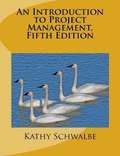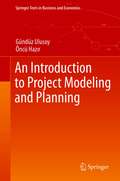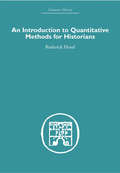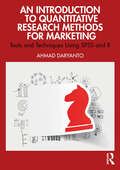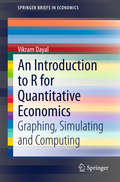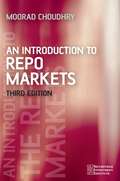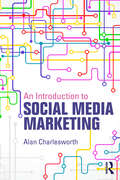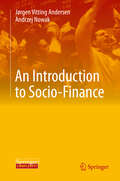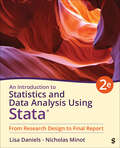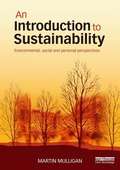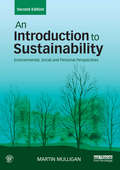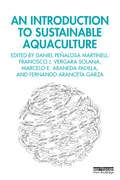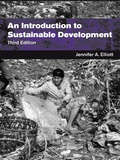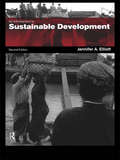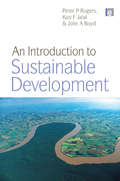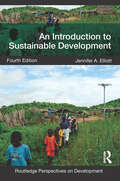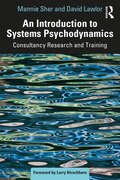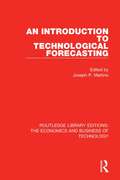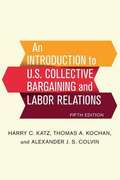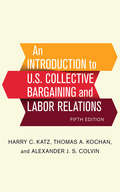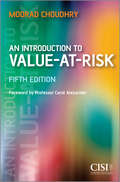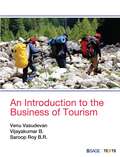- Table View
- List View
An Introduction to Project Management
by Kathy SchwalbeThe fifth edition of An Introduction to Project Management provides a separate chapter for planning integration and scope management and for planning time and cost management. Additional examples are provided for creating work breakdown structures and schedules. It also includes information on Basecamp, a free web-based project management tool, along with a user guide (replaces AtTask in Appendix B). In addition to updating many references and examples, this edition continues to include several popular features: - Follows the Project Management Institute's PMBOK® Guide, Fifth Edition (2013) - Has chapters for each process group and a comprehensive case study to illustrate applying tools and techniques throughout the project life cycle - Includes a Guide for using Microsoft Project 2013 - Provides a free trial of MatchWare's MindView Business software (www.matchware.com/intropm), a tool for creating mind maps, Gantt charts, and other project documents - Uses real-world examples and references, including opening cases and case wrap-ups, examples of what went right, what went wrong, media snapshots, best practices, and video highlights in each chapter - End of chapter materials include chapter summaries, quick quizzes, discussion questions, and exercises, with case studies provided in Appendix C -Comprehensive, secure instructor site available with lecture slides, solution files, test banks, etc. -Free Web site includes over fifty template files, online quizzes and games, data files for Project 2013, links to sites mentioned in the text, and much more.
An Introduction to Project Modeling and Planning (Springer Texts in Business and Economics)
by Gündüz Ulusoy Öncü HazırThis textbook teaches the basic concepts and methods of project management, but also explains how to convert it to useful results in practice. Project management offers a promising working area for theoretical and practical applications, and developing software and decision support systems (DSS). This book specifically focuses on project planning and control, with an emphasis on mathematical modeling. Models and algorithms establish a good starting point for students to study the relevant literature and support pursuing academic work in related fields. The book provides an introduction to theoretical concepts, and it also provides detailed explanations, application examples and case studies that deal with real life problems. The chapter topics include questions that underlie critical thinking, interpretation, analytics, and making comparisons. Learning outcomes are defined and the content of the book is structured in accordance with these goals. Chapter 1 begins by introducing the basic concepts, methods and processes of project management. Chapter 2 explores the fundamentals of organizing and managing projects from an organization’s perspective. Issues related to project team formation, role of project managers, and matrix organization are discussed. Chapter 3 is devoted to project modeling and planning. It explains how to collect proper data in order to perform an analysis and develop mathematical models. Chapter 4 introduces deterministic scheduling models, which can be used in constructing the time schedules. Models employing time-based and finance-based objectives are introduced. Chapter 5 focuses on the time/cost trade-off problem, explaining how to reduce the duration of some of the activities and therefore accelerate the project duration at the expense of additional costs. Chapter 6 introduces different resource management policies including resource portfolio management. Chapter 7 discusses models and methods of scheduling in case of uncertainty models and methods of scheduling in case of uncertainty. Chapter 8 highlights contract types and payment schedules. It explores identification and allocation of risk in contracts, project control issues, disputes and resolution management. Different models and decision support systems are presented in Chapter 9 in order to investigate client-contractor negotiations and the bidding process from different aspects. Chapter 10 covers monitoring and control, mainly the processes and methods behind them. Chapter 11 brings together qualitative and quantitative techniques with simulation and software applications. The design of a risk management process is introduced in detail and at the hand of a case study. Chapter 12 examines several models and approaches of uncertainty in project scheduling, dealing with various aspects of stochastic nature of the decision environment and robustness. Chapter 13 explains the mathematical formulation and solution procedures for resource constrained project scheduling. The project selection problem is inherently a multi-objective problem and is treated as such in Chapter 14. Several models and solution techniques including robust selection methods are introduced. Finally Chapter 15 evaluates recent approaches and promising research areas in project management including strategic project management, agile approaches, and data management in project modeling in the big data era.
An Introduction to Quantitative Economics (Routledge Library Editions: Econometrics #8)
by Brian HainesOriginally published in 1978. This book is designed to enable students on main courses in economics to comprehend literature which employs econometric techniques as a method of analysis, to use econometric techniques themselves to test hypotheses about economic relationships and to understand some of the difficulties involved in interpreting results. While the book is mainly aimed at second-year undergraduates undertaking courses in applied economics, its scope is sufficiently wide to take in students at postgraduate level who have no background in econometrics - it integrates fully the mathematical and statistical techniques used in econometrics with micro- and macroeconomic case studies.
An Introduction to Quantitative Methods for Historians (Economic History Ser.)
by Roderick FloudMany statements made by historians are quantitative statements, involving the use of measurable historical evidence. The historian who uses quantitative methods to analyse and interpret such information needs to be well acquainted with the particular methods and techniques of analysis and to be able to make the best use of the data that are available. There is an increasing need for training in such methods and in the interpretation of the large volume of literature now using quantitative techniques. Dr Floud’s text, which is relevant to all branches of historical inquiry, provides a straightforward and intelligible introduction for all students and research workers. The simpler and more useful techniques of descriptive and analytical statistics are described, up to the level of simple linear regression. Historical examples are used throughout, and great attention is paid to the need to ensure that the techniques are consistent with the quality of the data and with the historical problems they are intended to solve. Attention is paid to problems of the analysis of time series, which are of particular use to historians. No previous knowledge of statistics is assumed, and the simple mathematical techniques that are used are fully and clearly explained, without the use of more mathematical knowledge than is provided by an O-level course. A bibliography is provided to guide historians towards the most useful further reading. This student friendly text was first published in 1973.
An Introduction to Quantitative Research Methods for Marketing: Tools and Techniques Using SPSS and R
by Ahmad DaryantoThis introductory text covers the foundational concepts and statistical applications of quantitative research techniques using SPSS and R.Using step-by-step examples throughout, the book is broken down into six core sections: Part 1 covers an introduction to quantitative research methods and how to get started with SPSS and R; Part 2 covers basic concepts in measurement, data descriptions, and distributions; Part 3 discusses hypothesis testing, and basic statistical tests; Part 4 covers regression analysis; Part 5 discusses advanced topics in regression analysis and analysis of variance; and finally Part 6 covers advanced statistical methods. Each chapter contains learning objectives and summaries to structure learning, while breakout boxes provide tips and draw students’ attention to dos and don’ts in statistical research. SPSS and R Action Boxes present step-by-step instructions on how to perform statistical tests and procedures with SPSS and R. Review questions prompt self-reflection on concepts taught in each chapter and are complemented by exercises that allow students to put their learning into practice.A very applied text designed to make this complex subject accessible to students with no background in quantitative methods, this book is valuable recommended and core reading for advanced undergraduate and postgraduate students studying business and marketing research methods, business analytics, marketing analytics, statistical skills and quantitative methods.Online supplementary resources include data sets and programming files.
An Introduction to R for Quantitative Economics: Graphing, Simulating and Computing (SpringerBriefs in Economics)
by Vikram DayalThis book gives an introduction to R to build up graphing, simulating and computing skills to enable one to see theoretical and statistical models in economics in a unified way. The great advantage of R is that it is free, extremely flexible and extensible. The book addresses the specific needs of economists, and helps them move up the R learning curve. It covers some mathematical topics such as, graphing the Cobb-Douglas function, using R to study the Solow growth model, in addition to statistical topics, from drawing statistical graphs to doing linear and logistic regression. It uses data that can be downloaded from the internet, and which is also available in different R packages. With some treatment of basic econometrics, the book discusses quantitative economics broadly and simply, looking at models in the light of data. Students of economics or economists keen to learn how to use R would find this book very useful.
An Introduction to Repo Markets
by Moorad ChoudhryThe Repo markets have grown dramatically in the past few years because of the need to hedge short positions in the capital and derivatives markets. Virtually all major currency markets in the world now have an established repo market, the facility is also increasingly being used in developing currency markets as well.This book is a practical introduction that focuses on the instruments, applications and risk management techniques essential for this rapidly evolving market. Fully updated to reflect the changes in these markets, the book also includes worked examples and case studies, and new sections on basket and structured finance repo.
An Introduction to Robust Combinatorial Optimization: Concepts, Models and Algorithms for Decision Making under Uncertainty (International Series in Operations Research & Management Science #361)
by Michael Hartisch Marc GoerigkThis book offers a self-contained introduction to the world of robust combinatorial optimization. It explores decision-making using the min-max and min-max regret criteria, while also delving into the two-stage and recoverable robust optimization paradigms. It begins by introducing readers to general results for interval, discrete, and budgeted uncertainty sets, and subsequently provides a comprehensive examination of specific combinatorial problems, including the selection, shortest path, spanning tree, assignment, knapsack, and traveling salesperson problems. The book equips both students and newcomers to the field with a grasp of the fundamental questions and ongoing advancements in robust optimization. Based on the authors’ years of teaching and refining numerous courses, it not only offers essential tools but also highlights the open questions that define this subject area.
An Introduction to Social Media Marketing
by Alan CharlesworthSocial media has given marketers a way to connect with consumers in an unprecedented and revolutionary way, but the very newness of this medium is as challenging as it is exciting, particularly to those who aren't 'digital natives'. This is the first textbook for students that offers a step by step guide to this newly dominant marketing discipline. Mirroring its sister text Digital Marketing: a Practical Approach, this book is grounded in solid academic underpinnings, but has a lighter, hands-on approach that is perfect for shorter courses and additional reading. Chapter exercises not only help develop knowledge, but test the learners' understanding of how the various concepts and models are best used by requiring them to investigate how they are best applied in real-world scenarios. The book is supported by the author's excellent website, which includes links to continually updated statistics as well as articles that keep the reader in touch with the constant changes to this dynamic area. Topics covered in this book include: Social networking Consumer reviews Social service and support Real-time social media marketing Blogging Viral marketing and influencers Advertising on social media And much more. An Introduction to Social Media Marketing is the first of its kind and ideal reading for students who want to work in a digital marketing environment, as well as the traditional marketer who wants to get to grips with this vibrant, and potentially lucrative facet of present-day marketing.
An Introduction to Socio-Finance
by Andrzej Nowak Jørgen Vitting AndersenThis introductory text is devoted to exposing the underlying nature of price formation in financial markets as a predominantly sociological phenomenon that relates individual decision-making to emergent and co-evolving social and financial structures. Two different levels of this sociological influence are considered: First, we examine how price formation results from the social dynamics of interacting individuals, where interaction occurs either through the price or by direct communication. Then the same processes are revisited and examined at the level of larger groups of individuals. In this book, models of both levels of socio-finance are presented, and it is shown, in particular, how complexity theory provides the conceptual and methodological tools needed to understand and describe such phenomena. Accordingly, readers are first given a broad introduction to the standard economic theory of rational financial markets and will come to understand its shortcomings with the help of concrete examples. Complexity theory is then introduced in order to properly account for behavioral decision-making and match the observed market dynamics. This book is conceived as a primer for newcomers to the field, as well as for practitioners seeking new insights into the field of complexity science applied to socio-economic systems in general, and financial markets and price formation in particular.
An Introduction to Statistics and Data Analysis Using Stata®: From Research Design to Final Report
by Lisa Daniels Nicholas W. MinotAn Introduction to Statistics and Data Analysis Using Stata®: From Research Design to Final Report, Second Edition provides an integrated approach to research methods, statistics and data analysis, and interpretation of results in Stata. Drawing on their combined 25 years of experience teaching statistics and research methods, authors Lisa Daniels and Nicholas Minot frame data analysis within the research process—identifying gaps in the literature, examining the theory, developing research questions, designing a questionnaire or using secondary data, analyzing the data, and writing a research paper—so readers better understand the context of data analysis. Throughout, the text focuses on documenting and communicating results so students can produce a finished report or article by the end of their courses. The Second Edition has been thoroughly updated with all new articles and data—including coverage of ChatGPT, COVID-19 policies, and SAT scores—to demonstrate the relevance of data analysis for students. A new chapter on advanced methods in regression analysis allows instructors to better feature these important techniques. Stata code has been updated to the latest version, and new exercises throughout offer more chances for practice.
An Introduction to Statistics and Data Analysis Using Stata®: From Research Design to Final Report
by Lisa Daniels Nicholas W. MinotAn Introduction to Statistics and Data Analysis Using Stata®: From Research Design to Final Report, Second Edition provides an integrated approach to research methods, statistics and data analysis, and interpretation of results in Stata. Drawing on their combined 25 years of experience teaching statistics and research methods, authors Lisa Daniels and Nicholas Minot frame data analysis within the research process—identifying gaps in the literature, examining the theory, developing research questions, designing a questionnaire or using secondary data, analyzing the data, and writing a research paper—so readers better understand the context of data analysis. Throughout, the text focuses on documenting and communicating results so students can produce a finished report or article by the end of their courses. The Second Edition has been thoroughly updated with all new articles and data—including coverage of ChatGPT, COVID-19 policies, and SAT scores—to demonstrate the relevance of data analysis for students. A new chapter on advanced methods in regression analysis allows instructors to better feature these important techniques. Stata code has been updated to the latest version, and new exercises throughout offer more chances for practice.
An Introduction to Sustainability: Environmental, Social and Personal Perspectives
by Martin MulliganAn Introduction to Sustainability provides students with a comprehensive overview of the key concepts and ideas which are encompassed within the growing field of sustainability. The book teases out the diverse but intersecting domains of sustainability and emphasises strategies for action. Aimed at those studying the subject for the first time, it is unique in giving students from different disciplinary backgrounds a coherent framework and set of core principles for applying broad sustainability principles within their personal and professional lives. These include: working to improve equality within and across generations, moving from consumerism to quality of life goals and respecting diversity in both nature and culture. Areas of emerging importance such as the economics of happiness and wellbeing stand alongside core topics including: Energy and society Consumption and consumerism Risk and resilience Waste, water and land. Key challenges and applications are explored through international case studies and each chapter includes a thematic essay drawing on diverse literature to provide an integrated introduction to fundamental issues. Launched with the brand-new Routledge Sustainability Hub, the book's companion website contains a range of features to engage students with the interdisciplinary nature of Sustainability. Together these resources provide a wealth of material for learning, teaching and researching the topic of sustainability. This textbook is an essential companion to any sustainability course.
An Introduction to Sustainability: Environmental, Social and Personal Perspectives
by Martin MulliganAn Introduction to Sustainability provides students with a comprehensive overview of the key concepts and ideas which are encompassed within the growing field of sustainability. The fully updated second edition, including new figures and images, teases out the diverse but intersecting domains of sustainability and emphasises strategies for action. Aimed at those studying the subject for the first time, it is unique in giving students from different disciplinary backgrounds a coherent framework and set of core principles for applying broad sustainability principles within their own personal and professional lives. These include: working to improve equality within and across generations; moving from consumerism to quality of life goals; and respecting diversity in both nature and culture. Areas of emerging importance such as the economics of prosperity and wellbeing stand alongside core topics including: · Energy and society · Consumption and consumerism · Risk and resilience · Waste, water and land. Key challenges and applications are explored through international case studies, and each chapter includes a thematic essay drawing on diverse literature to provide an integrated introduction to fundamental issues. Housed on the Routledge Sustainability Hub, the book’s companion website contains a range of features to engage students with the interdisciplinary nature of sustainability. Together these resources provide a wealth of material for learning, teaching and researching the topic of sustainability. This textbook is an essential companion to any sustainability course.
An Introduction to Sustainable Aquaculture
by Daniel Peñalosa Martinell Vergara-Solana, Francisco J Araneda Padilla, Marcelo E Fernando Aranceta GarzaThis new textbook provides an accessible introduction to sustainable aquaculture through its relationship with three key pillars: the environment, the economy, and society.As the demand for seafood keeps increasing, aquaculture is considered one of the most promising and sustainable ways to satisfy this demand with nutritious and high-quality food. It is important to understand, therefore, the wider role and impact aquaculture has on the environment, the economy, and society. The book begins by providing a foundational introduction to aquaculture and sustainability, discussing the complex and interdependent relationship that exists between the two. The core text of the book is divided into four parts which focus on the environment, economics, social impacts, and governance and technologies. Chapters examine key issues surrounding climate change, food security, new technologies, bioeconomics and risk analysis, international cooperation, employment, and animal welfare, with the book concluding with a chapter examining the future directions and challenges for the aquaculture industry. The book draws on global case studies and each chapter is accompanied by recommended reading and chapter review questions to support student learning.This book will serve as an essential guide for students of aquaculture, fisheries management, and sustainable food, as well as practitioners and policymakers engaged in sustainable fishery development.
An Introduction to Sustainable Development
by Jennifer ElliottThis third edition of a successful, established text provides a concise and well-illustrated introduction to the ideas behind, and the practices flowing from the notion of sustainable development.
An Introduction to Sustainable Development
by Jennifer ElliottThis third edition of a successful, established text provides a concise and well-illustrated introduction to the ideas behind, and the practices flowing from the notion of sustainable development.
An Introduction to Sustainable Development
by Peter P. Rogers Kazi F. Jalal John A. BoydThis volume is the most comprehensive textbook on sustainable development. It has been developed with students and professionals from around the world specifically for those who need a thorough grounding in the subject. Coverage includes: background to sustainable development and global environmental issues; measurement and sustainability indicators; environmental assessment, management and policy; approaches and linkages to poverty reduction; impacts and infrastructure development; economics, consumption, production and market failures; governance; participation; disaster management; international financial institutions; international environmental agreements; and the role of civil society.
An Introduction to Sustainable Development (Routledge Perspectives on Development)
by Jennifer ElliottThis fourth edition has been comprehensively rewritten and updated to provide a concise, well illustrated and accessible introduction to the characteristics, challenges and opportunities of sustainable development with particular reference to developing countries. The contested nature of sustainable development is explored through a detailed consideration of changing ideas and practices within environmentalism and development thinking. The text identifies the different actors involved (from institutions of global governance through to community based organisations), the policies and mechanisms through which sustainable development is being sought and considers the outcomes for particular groups and environments in both rural and urban contexts. ?? This edition places stronger emphasis on the global challenges of sustainable development with an understanding of inter-linked crises in climate, energy, economy, poverty and social injustice. It explores how these issues are leading to deep questioning of what sustainable development is, what it should be, and how sustainable development policies and mechanisms are being reconsidered. The book gives new consideration to the challenge of achieving lower carbon growth, climate adaptation, and the implications on sustainable development of rapidly expanding economies, including China and India. It contains greater discussion of how civil society movements influence outcomes of international climate policy, as well as technological developments in energy and agriculture. The text also contains a substantially expanded discussion of how poverty remains central to sustainable development challenges, as revealed through the Millennium Ecosystem Assessment and Millennium Development Goals. This invaluable text retains the core message that sustainable development has become central to debates about environment and development. Containing a substantial number of new boxed case studies, learning outcomes, chapter summaries, discussion questions, further reading and websites, this text provides an essential introduction for students.
An Introduction to Systems Psychodynamics: Consultancy Research and Training
by Mannie Sher David LawlorThis book provides an introduction to systems psychodynamic theory and its application to organisational consultancy, research and training, outlining systems dynamics methods and their historical and theoretical developments. Systems Psychodynamics is an emerging field of social science, the boundaries of which are continually being refined and re-defined. The ‘systems’ designation refers to open systems concepts that provide the framing perspective for understanding the structural aspects of organisational systems. These include its design, division of labour, levels of authority, and reporting relationships; the nature of work tasks, processes, and activities; its mission and primary task; and the nature and patterning of the organisation’s task and sentient boundaries and the transactions across them. This book presents a critical appraisal of the systems psychodynamics paradigm and its application to present-day social and organisational difficulties, showing how a holistic approach to organisational and social problems can offer a fresh perspective on difficult issues. Bringing together the theory and practice of systems psychodynamics for the first time, this book provides an examination of the systems psychodynamics paradigm in action. This book gives an accessible and thorough guide to understanding and using systems psychodynamic ideas for analysts, managers, policy makers, consultants and researchers in a wide range of professional and clinical settings.
An Introduction to Technological Forecasting (Routledge Library Editions: The Economics and Business of Technology #31)
by Joseph P. MartinoOriginally published in 1972 this book examines technological forecasting and assesses its merits and limitations and possible uses for society, government, industry and the military. Although technological forecasting was in its infancy when this book was originally published, it has now become part of mainstream social and economic planning.
An Introduction to U. S. Collective Bargaining and Labor Relations (5th Edition)
by Thomas A. Kochan Harry C. Katz Alexander J. S. ColvinThis comprehensive textbook provides an introduction to collective bargaining and labor relations with a focus on developments in the United States. It is appropriate for students, policy analysts, and labor relations professionals including unionists, managers, and neutrals. A three-tiered strategic choice framework unifies the text, and the authors' thorough grounding in labor history and labor law assists students in learning the basics. In addition to traditional labor relations, the authors address emerging forms of collective representation and movements that address income inequality in novel ways.
An Introduction to U.S. Collective Bargaining and Labor Relations
by Thomas A. Kochan Alexander J. Colvin Harry C. KatzThis comprehensive textbook provides an introduction to collective bargaining and labor relations with a focus on developments in the United States. It is appropriate for students, policy analysts, and labor relations professionals including unionists, managers, and neutrals. A three-tiered strategic choice framework unifies the text, and the authors’ thorough grounding in labor history and labor law assists students in learning the basics. In addition to traditional labor relations, the authors address emerging forms of collective representation and movements that address income inequality in novel ways.Harry C. Katz, Thomas A. Kochan, and Alexander J. S. Colvin provide numerous contemporary illustrations of business and union strategies. They consider the processes of contract negotiation and contract administration with frequent comparisons to nonunion practices and developments, and a full chapter is devoted to special aspects of the public sector. An Introduction to U.S. Collective Bargaining and Labor Relations has an international scope, covering labor rights issues associated with the global supply chain as well as the growing influence of NGOs and cross-national unionism. The authors also compare how labor relations systems in Germany, Japan, China, India, Brazil, and South Africa compare to practices in the United States.The textbook is supplemented by a website (ilr.cornell.edu/scheinman-institute) that features an extensive Instructor’s Manual with a test bank, PowerPoint chapter outlines, mock bargaining exercises, organizing cases, grievance cases, and classroom-ready current events materials.
An Introduction to Value-at-Risk
by Carol Alexander Moorad ChoudhryThe value-at-risk measurement methodology is a widely-used tool in financial market risk management. The fifth edition of Professor Moorad Choudhry's benchmark reference text An Introduction to Value-at-Risk offers an accessible and reader-friendly look at the concept of VaR and its different estimation methods, and is aimed specifically at newcomers to the market or those unfamiliar with modern risk management practices. The author capitalises on his experience in the financial markets to present this concise yet in-depth coverage of VaR, set in the context of risk management as a whole.Topics covered include:Defining value-at-riskVariance-covariance methodologyPortfolio VaRCredit risk and credit VaRStressed VaRCritique and VaR during crisisTopics are illustrated with Bloomberg screens, worked examples and exercises. Related issues such as statistics, volatility and correlation are also introduced as necessary background for students and practitioners. This is essential reading for all those who require an introduction to financial market risk management and risk measurement techniques.Foreword by Carol Alexander, Professor of Finance, University of Sussex.
An Introduction to the Business of Tourism
by Venu Vasudevan B. VijayakumarThis textbook offers a lucid understanding of the business of tourism and helps students gain professional and entrepreneurial insights. An outcome of years of experience and practice, An Introduction to the Business of Tourism offers a fresh perspective of the skill-oriented, knowledge-based and multi-disciplinary arena of the tourism business. It presents a balanced mix of the basic principles and concepts, their application and policy implications as well as the business realities and operational aspects of the tourism industry. Divided into four sections and spread across nineteen chapters, this textbook delves deep into Indian and international tourism experiences with numerous integrated case studies and examples. Key Features: Special emphasis on recent business aspects of tourism from local and global perspectives Over 45 case studies to provide valuable insights into current business trends to strengthen the practical knowledge of students Each chapter has review questions and activities to support self-assessment. Book-end glossary of major concepts and terminologies to facilitate quick scan and easy understanding
